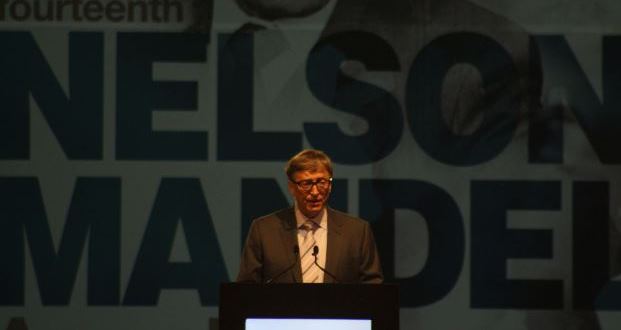After listening to Bill Gates delivering this year’s Nelson Mandela Annual Lecture, ALEX LENFERNA believes that Gates’ approach is misguided and demonstrates a misunderstanding of the current energy landscape, as well as the urgency of transitioning to clean energy technologies. He says Gates’ view is dangerous and might lead to us missing a vital window needed to transition to clean energy and avoid the worst impacts of climate change.
If a white man from the West came into town promising miracles that would save the planet and lift Africans out of poverty, you would be forgiven for thinking they were either a misguided preacher or someone suffering an acute version of the white saviour complex – or both. Yet Bill Gates did close to that when he delivered the 2016 Nelson Mandela Annual Lecture at the University of Pretoria last month.
According to Gates, what “Africa” (and the world) needs is a “breakthrough energy miracle that provides cheap, clean energy for everyone”. That’s not the first time he’s said that. Gates has been going around the world telling people that he can deliver energy miracles, and, to his credit, spending billions trying to do so. While this might not sound so bad, when viewed in the broader context of what he is preaching, it is deeply problematic.
The problem comes in when Gates asks us to wait for his so-called energy miracles, then downplays the need to deploy existing clean energy technologies, and spreads misinformation about the capability of current technologies.
Not only can we not afford to wait for Gates’ energy miracles, but we have many of the so-called miracles we need already. If we are to avert the worst impacts of climate change, and provide energy access to those without it, then we need to be rapidly putting in place the right climate and energy policies, investing in clean energy, and divesting from fossil fuels.
Why we don’t need (any more) miracles
During the Mandela lecture, Gates played up the role of large centralised energy projects like geothermal, hydro and fossil fuels. He then downplayed and even downright ignored the major role that wind and solar can and are playing in accelerating access to affordable, low-carbon energy. Gates’ approach stems from his incorrect belief, which he has been touting for over six years, that the only way current technology could reduce global greenhouse emissions is at “a beyond astronomical cost”, such that an energy “miracle” is necessary to avoid a climate catastrophe.
Evidence from right here in South Africa contradicts Gates’ misguided view. Our Centre for Scientific and Industrial Research (CSIR) has shown that wind is already providing energy to South Africa 40% cheaper than coal. Wind energy produced a net saving for the country of R1.8 billion in the first half of 2015 alone. Collectively the CSIR study showed that wind and solar had saved South Africa R4 billion from just January to June in 2015. We have also deployed cost-effective solar and storage plants which provide electricity 24 hours a day. And the prices of clean energy are only going down.
Across the globe, wind power is already one of our cheapest forms of energy, and solar is set to be one of the cheapest energy sources across 80% of the world by 2017, according to Deutsche Bank. With clean energy, batteries, and transportation, making such great headway, even the (deeply conservative) International Energy Agency has estimated that transitioning to clean energy in line with the 2-degree target is not only possible, but that it would result in net savings on fuel and energy costs of $71 trillion by 2050 – no miracles needed or astronomical costs incurred.
Urgent action is needed now
Even back in 2011, the International Energy Agency warned that “delaying action is a false economy: for every $1 of investment in cleaner technology that is avoided in the power sector before 2020, an additional $4.30 would need to be spent after 2020 to compensate for the increased emissions.”
Alongside increasing clean energy investments, the 2° Investing Initiative estimates that “divesting from fossil fuels is an integral piece to aligning the financial sector with a 2°C climate scenario,” with reductions in fossil fuel investments of $4.9 trillion needed by 2035 if we are to achieve the internationally agreed upon 2°C target.
As the Intergovernmental Panel on Climate Change stated in their 2014 report delaying action could “substantially increase the difficulty of the transition to low, longer-term emissions levels and narrow the range of options consistent with maintaining temperature change below 2 degrees C.” The IPCC warned that further delay risks “severe, pervasive and irreversible impacts for people and ecosystems.”
That’s why it’s so important that banks like Nedbank move rapidly to reduce their investments in fossil fuels (i.e. divest), and then reinvest in clean energy technologies. It’s also why it’s so important that in South Africa we push back against Eskom’s problematic monopoly on power production, which it is using to slow the needed uptake of clean energy investments.
When are the miracles coming?
Given the need for urgent action, it is worth asking: “When are Bill Gates’ miracles coming?”
To get a sense, we can have a look at some of the examples he has in mind. In a recent briefing authored by Gates, he highlighted three major technologies, namely, solar paint, solar chemical, and flow batteries. While each could maybe play an important role at some point, Gates admitted that none of those technologies would be ready to be deployed within the space of a decade. Still, Gates says he is optimistic that the next fifteen years will bring “the big breakthroughs we need”.
The problem, in the words of UN Climate Chief Christiana Figueres, is that the “investments that we’re going to make globally over the next five, 10, maximum 15 years, but certainly the ones within the next five years, will determine the quality of life of future generations, as simple as that.”
While Gates asks us to wait 15 years for an energy miracle, which may or may not pan out, studies, such as a major new study from NOAA and University of Colorado Boulder, show that “a transition to a reliable, low-carbon, electrical generation and transmission system can be accomplished with commercially available technology and within 15 years.”
So while actual energy experts tell us we can undertake the needed transition using predominantly the technologies we have, and climate experts warn that we need to act urgently within the next decade, Gates is telling us to sit back, hold tight, and trust him to develop an energy miracle sometime in the next fifteen years hopefully.
Editor’s note: A more comprehensive version of this article can be found here.










